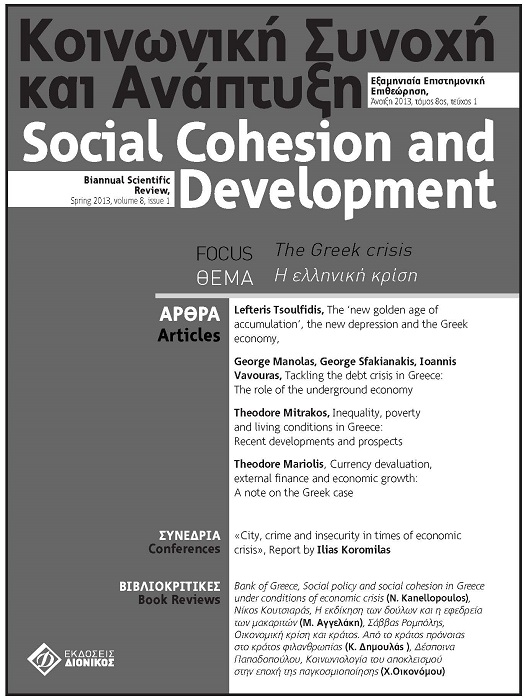Currency devaluation, external finance and economic growth: A note on the Greek case

Published:
Apr 13, 2016
Keywords:
Drachma Devaluation Greek Economy Dynamic Input-Output Price Models Thirlwall’s Model
Abstract
This paper combines dynamic input-output
price models with Thirlwall’s extended model
of balance of payments constrained growth to
estimate the effect of a switch to drachma on
domestic income. The findings suggest that a
return to national currency would not necessarily
deepen the recession, although a rather
large nominal devaluation, i.e. in excess of
57%-60%, is necessary for the recovery
Article Details
- How to Cite
-
Mariolis, T. (2016). Currency devaluation, external finance and economic growth: A note on the Greek case. Social Cohesion and Development, 8(1), 59–64. https://doi.org/10.12681/scad.9089
- Section
- Articles

This work is licensed under a Creative Commons Attribution-NonCommercial-ShareAlike 4.0 International License.
Authors who publish with this journal agree to the following terms:
- Authors retain copyright and grant the journal right of first publication with the work simultaneously licensed under a Creative Commons Attribution Non-Commercial License that allows others to share the work with an acknowledgement of the work's authorship and initial publication in this journal.
- Authors are able to enter into separate, additional contractual arrangements for the non-exclusive distribution of the journal's published version of the work (e.g. post it to an institutional repository or publish it in a book), with an acknowledgement of its initial publication in this journal.
- Authors are permitted and encouraged to post their work online (preferably in institutional repositories or on their website) prior to and during the submission process, as it can lead to productive exchanges, as well as earlier and greater citation of published work (See The Effect of Open Access).
Downloads
Download data is not yet available.
References
Bank of Greece (2012) Annual Report for the year 2011 (in Greek), Athens: Bank of Greece.
De Clementi M., Morciano M., Orlandi A. and Perrella R., (1988) Cumulative inflation and dynamic
input-output modelling, in: M. Ciaschini (ed.) (1988) Input-Output Analysis. Current
Developments, pp. 149-165, London: Chapman and Hall.
Economou G., Sampethai I. and Simigiannis G., (eds) (2010) The Current Account of Greece:
Imbalances and Policy Implications (in Greek), Athens: Bank of Greece.
Katsinos A. and Mariolis T., (2012) Switch to devalued drachma and cost-push inflation: a simple
input-output approach to the Greek case, Modern Economy, 3 (2), pp. 164-170.
Malliaropoulos D. and Anastasatos T., (2011) Competitiveness, External Deficit and External Debt
of the Greek Economy, Eurobank Research: Economy & Markets, 6 (7), April 2011.
McCombie J.S.L. and Thirlwall A.P., (1999) Growth in an international context. A Post Keynesian
view, in: J. Deprez J. and J.T. Harvey, (eds) (1999) Foundations of International Economics.Post Keynesian Perspectives, London: Routledge.
Papazoglou C.E., (2010) Introduction to International Economics (in Greek), Athens: Symeon.
Thirlwall A.P., (1979) The balance of payments constraint as an explanation of international
growth rate differences, Banca Nazionale del Lavoro Quarterly Review, 32 (128), pp. 45-53.
Thirlwall A.P., (2011) Balance of payments constrained growth models: history and overview, PSL
Quarterly Review, 64 (259), pp. 307-351.


